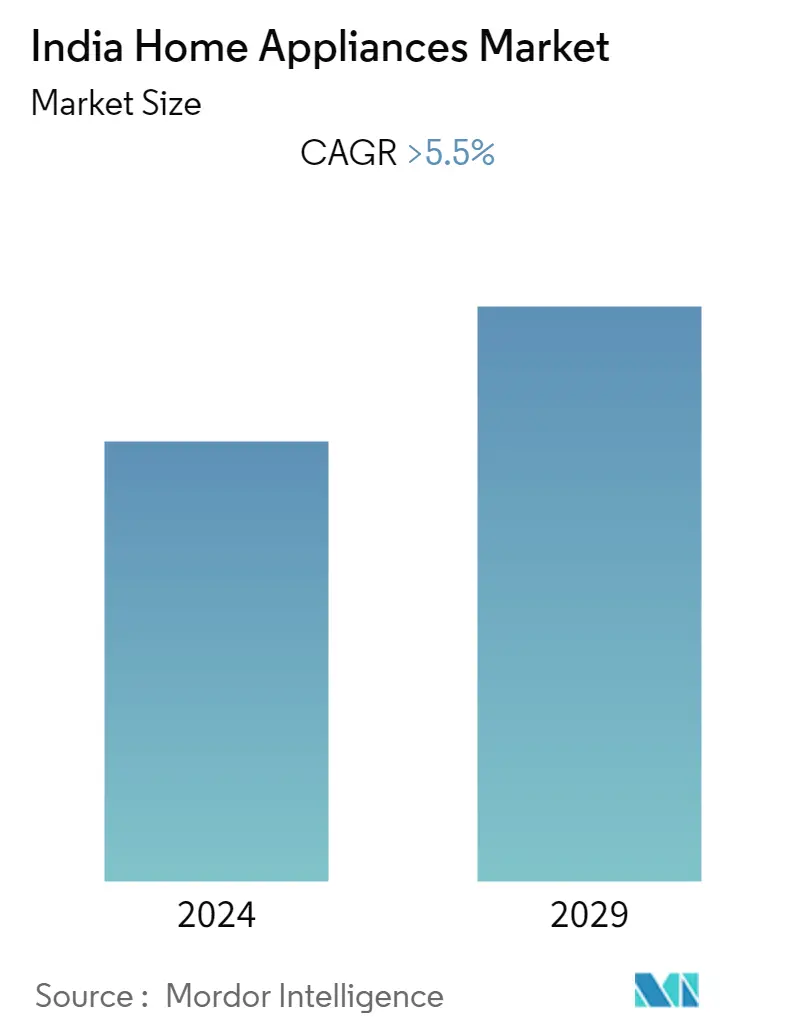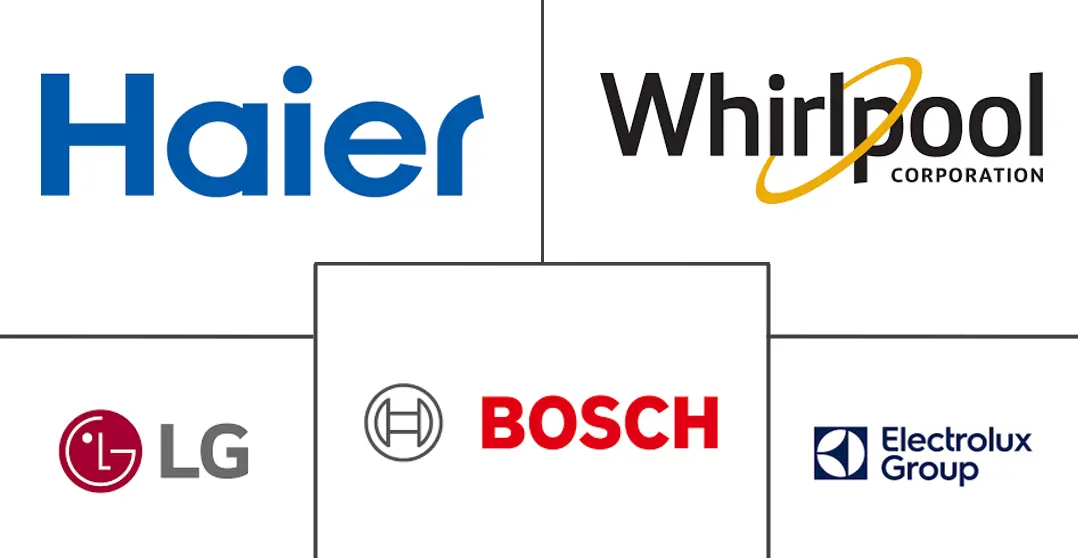Market Size of India Home Appliances Industry

| Study Period | 2020 - 2029 |
| Base Year For Estimation | 2023 |
| Forecast Data Period | 2024 - 2029 |
| Historical Data Period | 2020 - 2022 |
| CAGR | 5.50 % |
Major Players
*Disclaimer: Major Players sorted in no particular order |
India Home Appliances Market Analysis
Indian Home Appliances Market has generated USD 75 Billion in the current year and is poised to achieve a CAGR of 5.5% for the forecast period.
The home appliance industry is one of the fastest expanding in the Indian market. Home appliances in India have been expanding steadily, driven by both large and small appliances. In 2022, most household appliance categories had growth in both retail volume and current value. The industry has a sizable untapped market for appliances such as air conditioners (AC), washing machines, and refrigerators.
The growing economy and changing lifestyles of Indian consumers have resulted in an increase in the number of working individuals, nuclear families, single-person homes, and job migration. As a result, these emerging homes have a growing need for accessibility and are looking for items that provide convenience while significantly reducing the time and effort spent on daily activities. The emphasis on energy-efficient products, rising digital penetration, and rising aspirations are the key growth factors for this market. India's policies have undergone a tremendous transformation, particularly those that deal with the commercial and regulatory environments.
The industry may experience significant legislative changes as a result of the appliances sector and the impending national policy for electronics (NPE). The growing urban middle class and aspirational demand from rural India, together with government changes such as GST, are causing the appliances industry to look forward to the next phase of exponential expansion. This increase in India's consumer market demand is mostly driven by rising disposable incomes in Indian households and easy credit availability, which results in increased spending power. Increased electrification of rural regions, as well as the growing influence of social media and the popularity of online purchases, are all anticipated to drive up demand.
Due to COVID-19, lockdowns and social distancing, measures affected retailers with physical stores more than online retailers, ultimately accelerating the shift from brick-and-mortar to online retailing. It effected the major suppliers for the raw materials (used to manufacture devices) as well as the finished products. The industry faced a reduction in production, disruption in supply, and price fluctuations. While this has vastly encourage local manufacturers to step up and address the growing demand, the scarcity of raw material was still a challenge to this industry.
India Home Appliances Industry Segmentation
A home appliance, also referred to as a domestic appliance, an electric appliance, or a household appliance, is a machine that assists in household functions such as cooking, cleaning, and food preservation. A complete background analysis of the home appliances market, which includes an assessment of the national accounts, economy, and the emerging market trends by segments, significant changes in the market dynamics, and the market overview, is covered in the report. The Indian Home Appliances Market is segmented by Major Appliances (Refrigerators, Freezers, Dishwashing Machines, Washing Machines, Cookers, and Ovens), Small Appliances (Vacuum Cleaners, Small Kitchen Appliances, Hair Clippers, Irons, Toasters, Grills and Roasters, and Hair Dryers), and Distribution Channel (Multi-Branded Stores, Exclusive Stores, Online, and Other Distribution Channels). The market sizes and forecasts are provided in terms of value (USD billion) for all the above segments.
| By Product | ||||||||||
| ||||||||||
|
| By Distribution Channel | |
| Multi-Branded Stores | |
| Exclusive Stores | |
| Online | |
| Other Distribution Channels |
India Home Appliances Market Size Summary
The Indian home appliances industry is experiencing rapid growth, driven by a combination of economic development, evolving consumer lifestyles, and technological advancements. The market is characterized by a significant demand for both large and small appliances, with a notable untapped potential in categories such as air conditioners, washing machines, and refrigerators. The shift towards nuclear families, single-person households, and increased urbanization has heightened the need for convenient and energy-efficient appliances. Government policies and initiatives, such as the National Policy for Electronics and GST, are further propelling the industry towards substantial growth. The rise in disposable incomes, easy credit availability, and increased electrification in rural areas are also contributing to the expanding consumer market.
The market for smart home appliances is particularly vibrant, fueled by the growing number of smart homes and advancements in home automation. The integration of IoT and wireless communication technologies is enhancing the functionality and appeal of these appliances, driving their adoption. Smart washing machines, in particular, are gaining popularity due to increased internet and smartphone penetration. The competitive landscape is dominated by major players like Electrolux, Haier, LG Electronics, Bosch, Whirlpool, and Samsung, who are investing heavily in research and development to meet the tech-savvy demands of consumers. Product innovation and the introduction of features such as Wi-Fi connectivity and voice control are expected to sustain the market's growth trajectory in the coming years.
India Home Appliances Market Size - Table of Contents
-
1. MARKET DYNAMICS AND INSIGHTS
-
1.1 Market Overview
-
1.2 Market Drivers
-
1.2.1 Increasing Disposable Income and Urbanization
-
1.2.2 E-commerce and Digital Transformation
-
-
1.3 Market Restraints
-
1.3.1 Increased household appliance costs are impeding market expansion.
-
-
1.4 Market Opportunities
-
1.4.1 Technological Advancements:
-
1.4.2 Shift towards Energy Efficiency
-
-
1.5 Industry Attractiveness: Porter's Five Forces Analysis
-
1.5.1 Threat of New Entrants
-
1.5.2 Bargaining Power of Buyers
-
1.5.3 Bargaining Power of Suppliers
-
1.5.4 Threat of Substitutes
-
1.5.5 Intensity of Competitive Rivalry
-
-
1.6 Industry Value Chain Analysis
-
1.7 Technological Innovations driving the sales in the market
-
1.8 Government Regulations and Initiatives (Make in India, National Policy on Electronics, etc.)
-
1.9 Impact of COVID-19 on the Market
-
1.10 Insights on Setting up of Manufacturing Plants for Home Appliances in India
-
1.11 Insights on the Consumer Expenditure on Home Appliances and White Goods
-
-
2. MARKET SEGMENTATION
-
2.1 By Product
-
2.1.1 By Major Appliances
-
2.1.1.1 Refrigerators
-
2.1.1.2 Freezers
-
2.1.1.3 Dishwashing Machines
-
2.1.1.4 Washing Machines
-
2.1.1.5 Cookers and Ovens
-
-
2.1.2 By Small Appliances
-
2.1.2.1 Vacuum Cleaners
-
2.1.2.2 Small Kitchen Appliances (Food Procesors, Air Fryers, Mixer Grinders)
-
2.1.2.3 Hair Clippers
-
2.1.2.4 Irons
-
2.1.2.5 Toasters
-
2.1.2.6 Grills and Roasters
-
2.1.2.7 Hair Dryers
-
2.1.2.8 Water Purifiers
-
-
-
2.2 By Distribution Channel
-
2.2.1 Multi-Branded Stores
-
2.2.2 Exclusive Stores
-
2.2.3 Online
-
2.2.4 Other Distribution Channels
-
-
India Home Appliances Market Size FAQs
What is the current India Home Appliances Market size?
The India Home Appliances Market is projected to register a CAGR of greater than 5.5% during the forecast period (2024-2029)
Who are the key players in India Home Appliances Market?
Electrolux AB, Haier Electronics Group Co Ltd, LG Electronics, Robert Bosch GmbH and Whirlpool Corporation are the major companies operating in the India Home Appliances Market.

